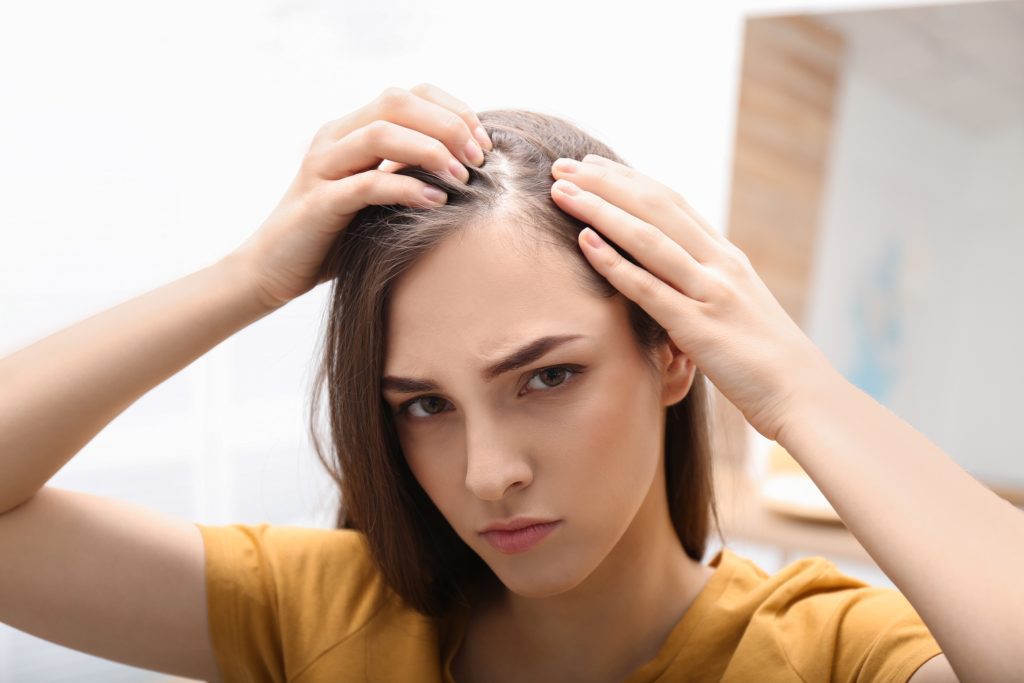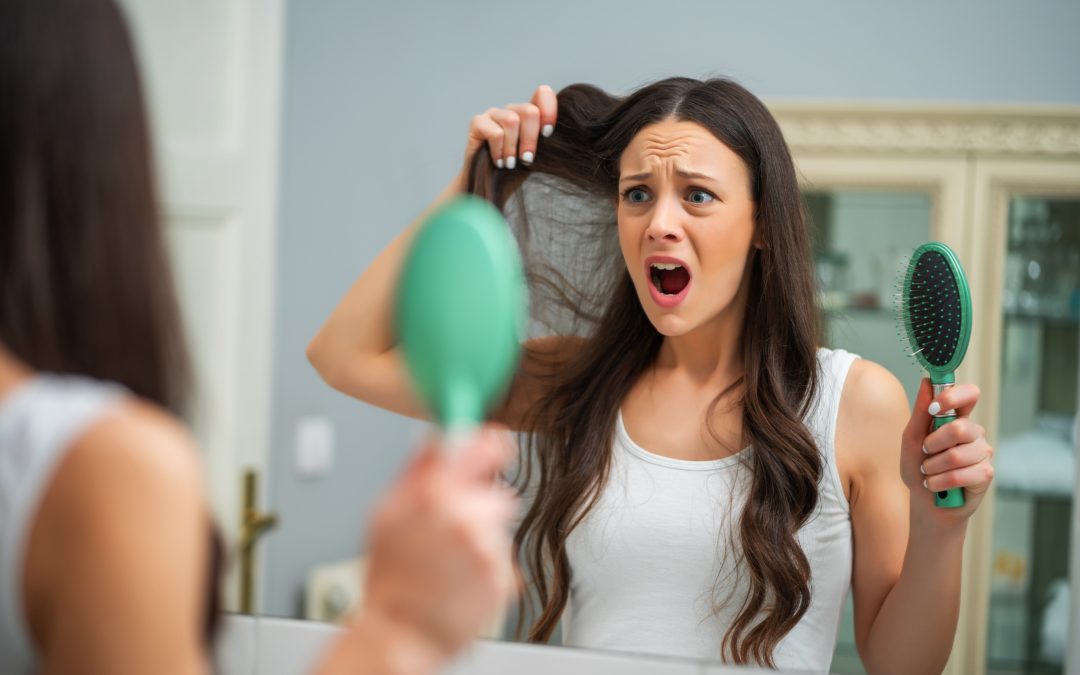Hair loss is a common occurrence, not just in men but women too. According to the Cleveland Clinic, 30 million women in the United States alone suffer from hair loss.
Women of all ages can experience moderate to severe hair loss, but it is more prevalent in certain age groups. Several reasons can provoke hair loss, ranging from styling, stress, medical and heredity issues.
Table of Contents
- 1 What Causes Hair Loss in Women
- 1.1 Our hair goes through three stages:
- 1.2 Anagen: This phase can last between two to eight years. This phase encompasses approximately 85 to 90% of your hair on the scalp.
- 1.3 Catagen: The catagen is the phase of transition in which your hair follicles shrink and can last from two to three weeks.
- 1.4 Telogen: This is the resting phase in which your hair falls out and can last around two to four months.
- 2 Causes of Hair Loss in Women
- 3 Health Conditions That Contribute to Women’s Hair Loss
- 4 Other Reasons for Hair Loss in Women
- 5 Best Hair Loss Treatment for Female
- 6 Conclusion
- 7 Hair Loss in Women FAQs
- 8 How can I stop my hair from falling out female?
- 9 What causes hair loss in female?
- 10 Can hair grow back after thinning?
- 11 What is the best vitamin for hair loss?
What Causes Hair Loss in Women

When you experience heavy hair fall daily, you live through the hair loss condition. On average, every human being sheds approximately fifty to one hundred hairs in a single day usually. However, if you notice losing more hair than usual, it is time to pay more attention to what could be causing this issue.
The natural hair growth cycle means that while you will shed some hair, others will begin to grow in their place. Hair loss occurs when you shed more hair than what is growing back. Please refer to the hair growth stages below to better understand this cycle.
Our hair goes through three stages:
-
Anagen: This phase can last between two to eight years. This phase encompasses approximately 85 to 90% of your hair on the scalp.
-
Catagen: The catagen is the phase of transition in which your hair follicles shrink and can last from two to three weeks.
-
Telogen: This is the resting phase in which your hair falls out and can last around two to four months.
Causes of Hair Loss in Women

A common misconception is that hair loss only occurs in men. However, the truth is that approximately fifty percent of women experience noticeable hair loss. Female pattern hair loss is the most significant of all other causes.
Several other reasons may also trigger hair loss, including alopecia, which is neither contagious nor in part due to nerves. According to Healthline, alopecia has four types and we have listed them below.
1.) Female Pattern Baldness
This is the leading form of alopecia in women is the female pattern baldness, which generally triggers due to family history or genetics. It can begin at any time, from twelve to forty years of age. Receding hairlines, as well as visible bald spots, are signs of hair loss in men. For women, however, hair loss generally appears as an overall hair thinning initially.
2.) Cicatricial Alopecia
This occurs when scarring gives rise to a series of conditions that result in irreversible hair loss. In this form, your hair falls out while scar tissues replace the follicle.
3.) Alopecia Areata
This is a condition where you may notice sudden appearances of round bald patches on your body or head. Around one or more round patches of baldness appear to mark this condition’s beginning in your, with the patches often overlapping.
4.) Traumatic Alopecia
This is when your hair styling regimes cause your hair to fall out. Harmful chemicals, hot styling tools, straightening, or dying your hair ultimately cause your hair shaft to break.
Health Conditions That Contribute to Women’s Hair Loss

Certain medical conditions also give way to hair loss, perhaps with hormonal disruption as in thyroid problems, celiac disease, autoimmune disorders, scars from certain skin conditions such as ringworm and others where your body may attack itself.
Overall, the conditions that may trigger hair loss in women can include:
-
Trichorrhexis invaginata
-
Scleroderma
-
Ringworm
-
Lichen planus
-
Celiac disease
-
Addison’s disease
-
Systemic lupus erythematosus
-
Hashimoto disease
-
Hypopituitarism
-
Hodgkin’s disease
-
Hyperthyroidism
Other Reasons for Hair Loss in Women

1.) Toxic substances
Such as radiation therapy, chemotherapy, and certain types of medications can cause hair loss in women, either on the scalp or elsewhere on the body. We refer to this category of hair loss as anagen effluvium. It generally occurs during the growth stage but may become a permanent condition if your follicles face damage.
2.) Extreme shock or stress
Women may experience temporary hair loss if they suffer extreme shock or stress to the body. Shock or stress causing events like delivering a baby, an illness, surgery, sudden weight loss, and others may cause temporary hair loss. We refer to this condition as telogen effluvium, which generally occurs in the resting stage.
3.) Hairstyles
Different hairstyles may also cause hair loss. If you regularly wear hairstyles that pull on your roots, such as cornrows, braids, or tight ponytails may cause hair loss. We refer to it as traction alopecia medically, and this loss may be permanent if you damage the hair follicles beyond repair.
4.) Menopause
During menopause, the production of hormones progesterone and estrogen reduce in women and may lead to hair fall.
5.) Discontinued birth control
This may also experience hair loss or perhaps hair thinning. Hormonal changes again, especially when the estrogen levels fall, can disrupt your hair cycle temporarily.
6.) A deficiency of minerals and vitamins
A deficiency of these nutrients in the body can cause hair loss or thinning in women. Many dermatologists believe that not eating sufficient portions of red meat or only consuming a vegetarian diet can be the cause of hair loss.
7.) Poor circulation
The hair follicles need proper blood flow, oxygen levels, and nutrients to support themselves. If there is poor blood circulation in the scalp, the hair will be deprived of all the proper minerals and nutrients they need to survive.
Best Hair Loss Treatment for Female

With the progress in medicine and technology, several treatments and medicines are available to treat hair loss arising from female-pattern baldness or forms of alopecia. However, it is best to consult a dermatologist regarding your hair loss problems and then decide the best course of treatment for your condition.
The options for hair loss treatment can include:
-
Laser Caps
-
DHT Blocking Shampoo
-
DHT Blocking Vitamins
-
Hair Restoration Surgery
-
Essential Oils
-
DIY Hair Growth Masks
-
At Home Hair Remedies
Conclusion

Hair loss is a common occurrence for both women and men. In most cases, it is usually a temporary situation. If you suspect you are losing more hair than is normal, you must immediately consult a medical expert. Seeking out the root cause by observing symptoms makes it easier to settle on the best treatment course for your hair loss conditions.
For more information relating to hair loss, check out this next article discussing causes of hair loss in men.
Hair Loss in Women FAQs
How can I stop my hair from falling out female?
Hair loss among females is extremely common. Approximately 30 million women in the U.S. alone suffer from hair loss. There are several treatment options available to help with female pattern baldness such as laser caps, hair masks, hair restoration surgeries, and more.
What causes hair loss in female?
There are several underlying factors that can contribute to female hair loss. These can include hormones, stress, genetics and more.
Can hair grow back after thinning?
Yes. It is possible for hair to grow back after thinning.
What is the best vitamin for hair loss?
One of the best vitamins for hair loss is a DHT blocking vitamin. These vitamins contain ingredients and enzymes to properly block the overproduction of the DHT hormone in the scalp.








